SCIENCE - 2009
Compt
Compt
(Set - III Outside Delhi )
Section A
Q.1. Why was the system of classification of elements into triads not found suitable? 1
Ans. The system of classification of elements into triads was not found suitable because it failed to arrange all the then known elements in the form of triads of elements having similar chemical properties. Only three triads from the elements known at that time could be identified.
Q. 2. What is a homologous series? 1
Ans. A homologous series is a group of organic compounds having similar structures and similar chemical properties in which the successive compounds differ by CH2 group.
Q. 3. State the first limitation of Mendeleev’s periodic table. 1
Ans. Limitation of Mendeleev’s periodic table:
- The position of isotopes could not be explained as isotopes are the atoms of the same element having similar chemical properties but different atomic masses.
Q. 4. Draw the structure of ethanol molecule.
Ans. Ethanol C2H5OH


Q. 5. A wire of resistance 4  is bent to form a closed square. What is the resistance across a diagonal of the square?
is bent to form a closed square. What is the resistance across a diagonal of the square?
 is bent to form a closed square. What is the resistance across a diagonal of the square?
is bent to form a closed square. What is the resistance across a diagonal of the square?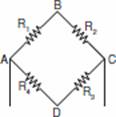
Ans. Total resistance of the wire = 4
AB = BC = CD = AD

Resistance across AC is given by R

Q. 6. Redraw the diagram given in your answer book and show the direction of the light ray after refraction from the lens. 1

Ans. When incident ray passes through the focus then refracted ray is parallel to the principal axis.

Q. 7. What is scattering of light? The colour of the sun looks different at different times of the day. Why? 2
Ans.
- Scattering of light means to throw light in various random directions. Light is scattered when it fall on various types of suspended particles in its path.
- The sun and the surrounding sky appear red at sunrise and sunset because at that time most of the blue colour present in sunlight has been scattered out and is away from our line of sight, leaving behind mainly red colour in the direct sunlight beam that reaches our eyes.
- The sun appears white when it is overhead in the sky because at that time the light coming from the sun has to travel a relatively shorter distance through the atmosphere to reach us so only a little of the blue colour of the white light is scattered and most of the blue light remains in it. Since sun has almost all its component colours in the right proportion therefore the sun appears white to us.
Q. 8. State Mendeleev’s periodic law. Write two achievements of Mendeleev’s periodic table. 2Ans.Q. 9. Stating two defects in the Mendeleev’s periodic table, explain why it was considered necessary to change the basis of classification of elements from atomic mass to atomic number. 2Ans. Defects in Mendeleev’s periodic table:
(i) The position of isotopes could not be explained because if the elements are arranged according to atomic mass, the isotopes should be placed in different groups but isotopes were not given separate places in the Mendeleev’s periodic table.
(ii) A correct position could not be assigned to hydrogen in the periodic table as some of its properties resemble those of alkali metals and some of its properties resemble the properties of halogens. The failure of Mendeleev’s periodic law to explain the position of isotopes, wrong order of atomic masses of some elements and position of hydrogen suggested that atomic mass can not be the basis for the classification of elements.Q. 10. When we immerse a big iron nail in copper sulphate solution taken in a beaker, after about 20 minutes we observe a brownish precipitate on the iron nail and the blue colour of copper sulphate solution fades. What is this type of reaction? State the conclusion you can draw from this observation. 2Ans. When an iron nail is dipped in copper sulphate solution, then iron sulphate solution and copper metal are formed.
 In this reaction, iron displaces copper from copper sulphate solution. The deep blue colour of copper sulphate solution fades due to the formation of light green solution of iron sulphate. A reddish brown coating of copper metal is formed on the surface of the iron nail. This is an example of a displacement reaction.Q. 11. What is a soap? Explain the mechanism of its cleansing action. Why does soap not work well with hard water? 3Ans.
In this reaction, iron displaces copper from copper sulphate solution. The deep blue colour of copper sulphate solution fades due to the formation of light green solution of iron sulphate. A reddish brown coating of copper metal is formed on the surface of the iron nail. This is an example of a displacement reaction.Q. 11. What is a soap? Explain the mechanism of its cleansing action. Why does soap not work well with hard water? 3Ans.- A soap is the sodium salt (or potassium salt) of a long chain carboxylic acid (fatty acid) which has cleansing properties in water.
- Cleansing action.
- Soap does not work well with hard water because hard water contains soluble salts of Ca and Mg. When soap is dissolved in it, insoluble salts of Ca2+ and Mg2+are formed which are called scum. The scum sticks to the clothes being washed and interferes with the cleaning ability of the soap.
Q. 12. What is ethanol? Draw the structure of ethanol molecule. How does ethanol behave with the following :
(a) Sodium
(b) Excess of conc. sulphuric acid at 443 K
Write chemical equation for each reaction. 3
Ans.
(a) Sodium
(b) Excess of conc. sulphuric acid at 443 K
Write chemical equation for each reaction. 3
Ans.
- Ethanol is the second member of the homologous series of alcohol. It’s formula is C2H5OH. It is the most widely used alcohol. It’s common name is ethyl alcohol.
- Structure formula

- Ethanol reacts with sodium to form sodium ethoxide and hydrogen gas

- When ethanol is heated with excess of conc. sulphuric acid at 443 K, it gets dehydrated to form ethene

Q. 13. Draw a schematic diagram of an electric circuit consisting of a battery of four 1·5 V dry cells, a 18 resistor, a 12
resistor, a 12  resistor, a plug key, all connected in series. Calculate the value of current flowing through the 18
resistor, a plug key, all connected in series. Calculate the value of current flowing through the 18  resistor and the power consumed by the 12
resistor and the power consumed by the 12  resistor. 3
resistor. 3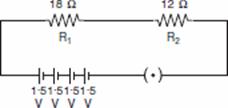
Ans. Total potential difference, V = 4 X 1·5 = 6 volts
Resultant resistance, R = R1 + R2 = 18 + 12 = 30
Current, I I=
I= Since current remains constant in a series,
Since current remains constant in a series, Q. 14. Draw a schematic diagram of an electric circuit consisting of a battery of six 2 V cells, a 10
Q. 14. Draw a schematic diagram of an electric circuit consisting of a battery of six 2 V cells, a 10 resistor, a 20
resistor, a 20  resistor, a plug key, all connected in series. Calculate the value of current flowing through the 10
resistor, a plug key, all connected in series. Calculate the value of current flowing through the 10  resistor and the power consumed by the 20
resistor and the power consumed by the 20  resistor.Ans.
resistor.Ans.
 R1 = 10
R1 = 10 and R2 = 20
and R2 = 20 
Resultant resistance, R = R1 + R2
R = 10 + 20 = 30
Total voltage = 12 volts
Total current, I = ?
V = I R
I =

Q.15. (a) What is a reactivity series? Describe an activity to develop a reactivity series.
(b) Write two physical and two chemical properties of non-metals. 5Ans. (a) The arrangement of metals in a vertical column in the order of their decreasing reactivities is called reactivity series of metals.
Activity:- Some metals are chemically very reactive whereas others are less reactive e.g. potassium and sodium react vigorously with cold water so these are very-very reactive metals.
- Calcium reacts with cold water but not vigorously.
- Magnesium does not react with cold water but reacts with hot water.
- Aluminium and zinc react with steam so these metals are less reactive than Magnesium.
- Iron does not react with steam but red hot iron reacts with steam so iron is less reactive than aluminium and zinc.
- Whereas copper and silver do not react with water at all. So they are very-very less reactive metals.
So on the basis of reaction of metals with water, we can arrange.
K > Na > Ca > Mg > Al > Zn > Fe > Cu > Ag.
(b) Two physical properties of non-metals
• Non-metals are neither malleable nor ductile.
• Non-metals do not conduct heat and electricity.
Two chemial properties of non-metals
• Reaction of non-metals with oxygen
Non-metals react with oxygen to form acidic oxides or neutral oxides.

• Reaction of non-metals with chlorine
Non-metals react with chlorine to form covalent chlorides which are non-electrolytes.
• Non-metals are neither malleable nor ductile.
• Non-metals do not conduct heat and electricity.
Two chemial properties of non-metals
• Reaction of non-metals with oxygen
Non-metals react with oxygen to form acidic oxides or neutral oxides.

• Reaction of non-metals with chlorine
Non-metals react with chlorine to form covalent chlorides which are non-electrolytes.

Or
(a) What is meant by corrosion? Name any two methods used for the prevention of corrosion.
(b) Suppose you have to extract metal M from its enriched sulphide ore. If M is in the middle of the reactivity series write various steps used in extracting this metal. 5
(b) Suppose you have to extract metal M from its enriched sulphide ore. If M is in the middle of the reactivity series write various steps used in extracting this metal. 5
Ans. (a) The eating up of metals by the action of air, moisture or a chemical (such as an acid) on their surface is called corrosion.
Prevention of corrosion:
(i) Corrosion or rusting of iron can be prevented by painting, oiling, greasing, galvanising, crome plating, anodising.
(ii) Corrosion of metals can also be prevented by alloying them with suitable metals or non metals in a required proportion.
Prevention of corrosion:
(i) Corrosion or rusting of iron can be prevented by painting, oiling, greasing, galvanising, crome plating, anodising.
(ii) Corrosion of metals can also be prevented by alloying them with suitable metals or non metals in a required proportion.
(b) M is in the middle of the reactivity series. Various steps which can be used to extract it from its enriched sulphide ore are as follows:
(i) Roasting: The enriched sulphide ore of ‘M’ is strongly heated in the presence of air to convert it into metal oxide.
(ii) Reduction: The metal oxides obtained by roasting is converted to free metal ‘M’ by reducing agents like carbon, aluminium, sodium or calcium.
(iii) Refining: The metal ‘M’ obtained by reduction contains some impurities. Thus this impure metal ‘M’ undergoes purification. The process of purifying impure metal is called refining. The most widely used method for refining is electrolytic refining.
(i) Roasting: The enriched sulphide ore of ‘M’ is strongly heated in the presence of air to convert it into metal oxide.
(ii) Reduction: The metal oxides obtained by roasting is converted to free metal ‘M’ by reducing agents like carbon, aluminium, sodium or calcium.
(iii) Refining: The metal ‘M’ obtained by reduction contains some impurities. Thus this impure metal ‘M’ undergoes purification. The process of purifying impure metal is called refining. The most widely used method for refining is electrolytic refining.
Q.16. (a) State Fleming’s left-hand rule. Apply this rule and find the direction of force acting on the electron that enters a magnetic field at right angles to it as shown in the figure. 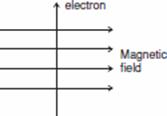
(b) When is an electric circuit said to be overloaded? State two measures to avoid it. What name is given to a situation in which the live and the neutral wires accidentally come in contact? State the role a safety device may play in this situation.

(b) When is an electric circuit said to be overloaded? State two measures to avoid it. What name is given to a situation in which the live and the neutral wires accidentally come in contact? State the role a safety device may play in this situation.
Ans. (a) According to Fleming’s Left Hand Rule: Hold the forefinger, the centre finger and the thumb of your left hand at right angles to one another. Adjust your hand in such a way that the forefinger points in
the direction of magnetic field and the centre finger points in the direction of current, then the direction in which thumb points, gives the direction of force acting on the conductor.
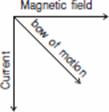
• In the given example the direction of force acting on the electron is out of the page because the direction of force is perpendicular to the direction of magnetic field and current given by Fleming’s Left Hand Rule. The direction of current is taken opposite to the direction of motion of electrons i.e. in this case in the downward (south) direction and direction of magnetic field is towards east. Therefore the force is directed out of the page.
the direction of magnetic field and the centre finger points in the direction of current, then the direction in which thumb points, gives the direction of force acting on the conductor.

• In the given example the direction of force acting on the electron is out of the page because the direction of force is perpendicular to the direction of magnetic field and current given by Fleming’s Left Hand Rule. The direction of current is taken opposite to the direction of motion of electrons i.e. in this case in the downward (south) direction and direction of magnetic field is towards east. Therefore the force is directed out of the page.
(b) Overloading and measures to avoid it:
• When the live and the neutral wires accidentally come in contact, this situation is known as short-circuiting.
• A fuse is the most important safety device. A fuse is a safety device having short length of a thin, tin-plated copper wire having low melting point, which melts and breaks if the current exceeds a safe value. A fuse is used for protecting the circuits and electric appliances from damage at the time of overloading or shortcircuiting of the circuits.
• When the live and the neutral wires accidentally come in contact, this situation is known as short-circuiting.
• A fuse is the most important safety device. A fuse is a safety device having short length of a thin, tin-plated copper wire having low melting point, which melts and breaks if the current exceeds a safe value. A fuse is used for protecting the circuits and electric appliances from damage at the time of overloading or shortcircuiting of the circuits.
Or
(a) With the help of a diagram describe in brief an activity to show that a magnetic field is produced by a current carrying circular coil. Draw a diagram to show the pattern of the magnetic field lines in this case.
(b) State the function of the earth wire in domestic electric circuits. Why is the metallic body of an electric appliance connected to the earth wire? Write the colour used for insulation of the earth wire.
Ans. (a) Magnetic field produced by a current carrying circular coil.
(i) A rectangular card board having holes is taken and a circular coil having large number of turns is
inserted in the cardboard. The coil should be inserted in the cardboard in such a manner that the
coil is normal to the plane of the cardboard.
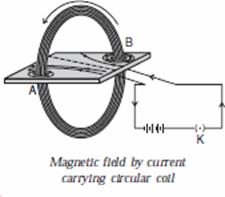
(i) A rectangular card board having holes is taken and a circular coil having large number of turns is
inserted in the cardboard. The coil should be inserted in the cardboard in such a manner that the
coil is normal to the plane of the cardboard.

(ii) The ends of the coil are connected in series with a battery, a key and a rheostat.
(iii) Then iron filings are sprinkled uniformly on the cardboard.
(iv) Now the key is plugged.
(v) On tapping the cardboard gently, the circular magnetic field lines near the current carrying loop are observed. On moving away from the circular loop, the concentric circles representing magnetic field lines become bigger and bigger. At the centre of the circular loop, the magnetic field lines are straight.
(b) The earth wire is used as a safety measure for electrical appliances having a metallic body. e.g., electric press, toaster, table fan, refrigerator etc. The earth wire, which has insulation of green colour is usually connected to a metal plate dug deep inside the earth near the house. The leaked current from the appliance passes directly to the earth through the earth wire. Actually a very heavy current flows through the earth wire and the fuse of household wiring melts and cuts off the power supply. The appliance having metallic body is connected to the earth wire as it provides a low-resistance conducting path for the current. Thus it ensures that any leakage of current to the metallic body of the appliance keeps its potential to that of the earth, and the user does not get a severe electric shock.
Section B
Q. 17. State what type of method is used for growing jasmine plant. 1
Ans. Layering.
Q. 18. State two changes you can make in your habits to reduce the consumption of electricity or water. 1
Ans. For reducing consumption of electricity:
(i) I will use stairs to climb at least up to three floors of a building instead of taking a lift.
(ii) I will use CFL bulbs and lights instead of traditional lamps which consume more energy.
(iii) To reduce consumption of water, I will close the tap while brushing my teeth and use a bucket of water to have a bath instead of a shower.
(i) I will use stairs to climb at least up to three floors of a building instead of taking a lift.
(ii) I will use CFL bulbs and lights instead of traditional lamps which consume more energy.
(iii) To reduce consumption of water, I will close the tap while brushing my teeth and use a bucket of water to have a bath instead of a shower.
Q. 20. Write the name and functions of any two parts of the human hind brain. 2
Ans. Pons, Cerebellum and Medulla are the parts of hind brain
• The pons take part in regulating respiration.
• Cerebellum helps to maintain posture and balance of the body.
• The pons take part in regulating respiration.
• Cerebellum helps to maintain posture and balance of the body.
Q. 21. State two problems caused by biodegradable waste that we generate in our daily life. 2
Ans. Problems caused by biodegradable waste in our daily life.
(i) When biodegradable wastes are collected in the form of garbage, these provide a lot of organic matter for the decomposers. During decomposition of these wastes, foul smell and some harmful gases are given out in the environment.
(ii) Organic matter of biodegradable substances cause the growth of mosquitoes and flies which act as vectors for the disease causing microbes.
(i) When biodegradable wastes are collected in the form of garbage, these provide a lot of organic matter for the decomposers. During decomposition of these wastes, foul smell and some harmful gases are given out in the environment.
(ii) Organic matter of biodegradable substances cause the growth of mosquitoes and flies which act as vectors for the disease causing microbes.
Q. 22. State two problems caused by the non-biodegradable waste that we generate in our daily life. 2
Ans. Problems caused by the non-biodegradable waste:
(i) Non-biodegradable wastes cannot be made less toxic easily and hence they are major pollutants of the environment.
(ii) Non-biodegradable waste can be passed along the food chain from crops to man and other animals and harm them.
(i) Non-biodegradable wastes cannot be made less toxic easily and hence they are major pollutants of the environment.
(ii) Non-biodegradable waste can be passed along the food chain from crops to man and other animals and harm them.
Q. 23. What is regeneration? State a reason why a more complex organism cannot give rise to new individuals through this method. 2
Ans. Regeneration. The process of getting back a full organism from its body parts is called regeneration. The simple animals like hydra and planaria show regeneration.
In complex multicellular organisms, specialised cells make up tissues; tissues make up organs; organs make up organ system; and finally organ system make up organisms. Since complex multicellular organisms have a very high degree of organisation in their body, they cannot be reproduced from their cut body parts by the process of regeneration.
In complex multicellular organisms, specialised cells make up tissues; tissues make up organs; organs make up organ system; and finally organ system make up organisms. Since complex multicellular organisms have a very high degree of organisation in their body, they cannot be reproduced from their cut body parts by the process of regeneration.
Q.24. What are plant hormones? Write two important functions of auxin. 2
Ans. Plant hormones are special type of chemicals secreted by the plants to control and coordinate plant growth, development and responses to the environment.
Functions of Auxins:
(i) It promotes cell enlargement and cell differentiation.
(ii) It promotes fruit growth.
(i) It promotes cell enlargement and cell differentiation.
(ii) It promotes fruit growth.
Q. 25. The human beings who look so different from each other in terms of colour, size and looks are said to belong to the same species. Why? Justify your answer. 3
Ans. The human beings who look so different from each other in terms of colour, size and looks are said to belong to the same species because the process of reproduction can occur between them. These differences are known as variations, i.e. the occurrence of differences among the individuals of a species. Although all human beings look different, they have the same number of chromosomes. A large number of variations occur in sexual reproduction because two parents are involved in the process and result in the birth of human beings of different colour, size and looks.Q. 26. What is meant by sustainable management? The environmentalists are insisting upon sustainable natural resources management”. State its four advantages. 3
Ans. The development which meets the current basic human needs and also preserves the resources for the needs of future generations is called sustainable management.
A system of controlling the use of natural resources in such a way as to avoid their wastage and to use them in the most effective way is called sustainable management.
A system of controlling the use of natural resources in such a way as to avoid their wastage and to use them in the most effective way is called sustainable management.
Advantages:
(i) The resources of the earth are limited. Proper management of these natural resources can ensure that these are used judiciously so that they fulfil the needs of the present generation and also last for the
generations to come.
(ii) The proper management of natural resources takes into consideration long-term perspective and prevents their exploitation to the hilt for short term gains.
(iii) Proper management can ensure equitable distribution of natural resources so that all the people can be benefitted.
(iv) Proper management will take into consideration the damage caused to the environment during the extraction or use of the natural resources and find ways and means to minimize the damage.
(i) The resources of the earth are limited. Proper management of these natural resources can ensure that these are used judiciously so that they fulfil the needs of the present generation and also last for the
generations to come.
(ii) The proper management of natural resources takes into consideration long-term perspective and prevents their exploitation to the hilt for short term gains.
(iii) Proper management can ensure equitable distribution of natural resources so that all the people can be benefitted.
(iv) Proper management will take into consideration the damage caused to the environment during the extraction or use of the natural resources and find ways and means to minimize the damage.
Q.27. (a) Draw a diagram to show the human alimentary canal and label on it the following :
Gall bladder, stomach Name the longest part of the alimentary canal.
(b) Why is it necessary to separate oxygenated and deoxygenated blood in mammals and birds? 5
Gall bladder, stomach Name the longest part of the alimentary canal.
(b) Why is it necessary to separate oxygenated and deoxygenated blood in mammals and birds? 5
Ans. (a) Human alimentary canal.
Longest part of the alimetary canal is small intestine (about 7 m long).
(b) Such separation of oxygenated and deoxygenated blood is necessary for highly efficient supply of oxygen to the body of birds and mammals which have high energy needs and constantly need energy
to maintain their body temperature.
Longest part of the alimetary canal is small intestine (about 7 m long).
(b) Such separation of oxygenated and deoxygenated blood is necessary for highly efficient supply of oxygen to the body of birds and mammals which have high energy needs and constantly need energy
to maintain their body temperature.
Or
(a) Draw a diagram to show excretory system in human beings and
label on it the following:
Aorta, Vena Cava
Name the excretory unit of kidney.
label on it the following:
Aorta, Vena Cava
Name the excretory unit of kidney.
(b) Differentiate between aerobic respiration and anaerobic respiration. After vigorous exercise, athletes and players generally experience cramps in their leg muscles. Why? 5
Ans. (a) Excretory System in human beings.Nephron is the excretory unit of kidney.
(b) Difference between aerobic respiration and anaerobic respiration.After vigorous exercise, athletes and players generally experience cramps in their leg muscles because anaerobic respiration takes place in the muscles during vigorous physical exercise. Oxygen gets used up faster in the muscle cells than that can be supplied by the blood. Anaerobic respiration produces lactic acid with release of a small amount of energy. The sudden build up of lactic acid in the muscles causes muscular cramps.
No comments:
Post a Comment